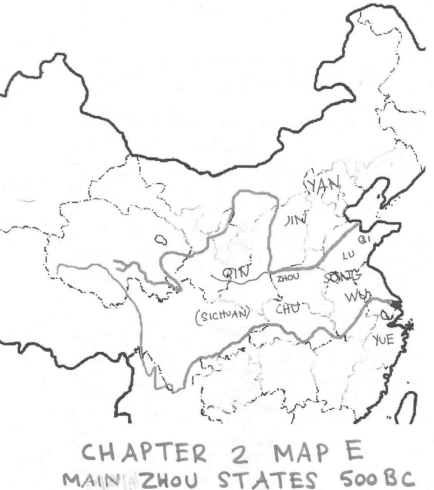2.5: Relations with Other Peoples
- Page ID
- 135203
But did that mean that they thought of people to the north as “barbarians”? Textbooks and historians use this English term to translate many different words in Chinese, which has the effect of naturalizing the supposed ethnic unity of “the Chinese” as distinct from “barbarians.” As the feudal lords built up their domains and swallowed up their neighbors, they began to call their domains “states,” and as a group, the “central states” 中國. Those states managed political rivalries and alliances within a very mixed, multi-ethnic world.
The northern Di and western Rong groups, for starters, lived over a wide area in northern Shanxi, Shaanxi and Hebei, normally scattered but sometimes allying with one another (see Map D). Some Zhou texts, including the Zuo Commentary, say they are like animals, or wolves, and unlike the “Xia” people – the Zhou states. But each case of rhetoric about Di or Rong sub humanity occurs in a particular political conflict between Zhou domains with Di or Rong as allies of one side. Just as diplomats made speeches referring to kinship among the states in order to achieve some alliance or other aim, so they also talked about the wolvish characteristics of the non-Xia groups. In fact, they described Zhou domains in the same way at times. People with different lifeways were identified as foreign, but their interactions with the Zhou domains – now becoming independent states – did not occur along clear Us vs. Them lines.11
Rather, relations on the northern frontier were pragmatic. Defense and survival on the one hand, and aggressive expansion on the other, both required ever more resources as the warfare among the Zhou states ramped up. Zhou states took three practical approaches to northern groups. First, where possible, you should conquer the non-Zhou to expand and enslave them. Second, if that would be too expensive or dangerous, or if you need allies, make peace with them. Third, if you are able, incorporate them the administrative structure of your state, in order to effectively use them for fiscal and military purposes – just as you do other people. When a state chose one or another approach, they couched it in moral terms for publicity, but that does not mean the choices were made for moral principled reasons.
In 770 the Rong people attacked the western Zhou capital and forced the Zhou king to move east, but Zhou states continued to ally with the Rong and Di groups as often as they fought with them. For instance, in 721 BC the state of Lu (where Confucius lived two centuries later) made a covenant with Rong. Such treaties, when made among Zhou states, typically specified ending fighting, being good neighbors, helping each other, and allying against a common enemy. Treaties were made with the Rong or Di on the same terms and through the same diplomatic and ritual steps that governed Zhou states’ relations with one another: negotiations in visits to each other’s courts, with gifts, followed by ratification in a ceremony in which blood covenants were made. The blood covenant as reconstructed by Mark Edward Lewis involved the participants purifying themselves through fasting while workers erected an altar and dug a pit. A sheep would be sacrificed in the pit, its ear cut off and placed in a vessel, and the blood caught in another vessel for the participants to drink (yum!).
The alliances with Di and Rong were real, and even oaths between Zhou states were broken, in the realpolitik context of competition among Zhou states against for resources – farmers, soldiers, land. Then end result, by 500, was the full integration of Di and Rong people as military forces into Zhou states. Having eliminated the buffer zone, the Zhou states found themselves facing the much more formidable mounted Northern Zone nomads.
Nomadism had developed on the Central Asian steppe around 1500 BC, about the same time as the Shang got their start. They lived by nomadic pastoralism, a method of production in which people moved herds of animals through the landscape as the seasons changed, seeking pasture. The society and culture of nomads diverged from those of agricultural people as the two modes of production diverged from their shared prehistoric roots: domestication of grain and small animals. In about 1000 BC, people learned to ride horses. By about 900 BC, nomadism had migrated from the steppe highway east to Manchuria: archaeologists have found large numbers of buried horses, horse fittings, and weapons. Instead of the immensely heavy bronze vessels of the agricultural zone, the warriors who formed the steppe elite marked their status with portable art in the shape of animals and elaborate horsegear. From about 600-300 BC, concurrent with the Warring States period, the steppe culture of warriors who dominated herders and farmers spread all along the northern frontier of the Zhou states, developing local cultures that interacted with each other and to some extent with the Zhou states.



